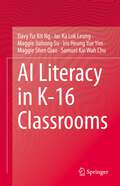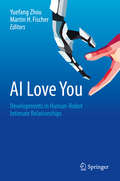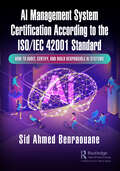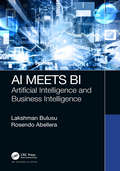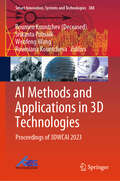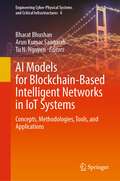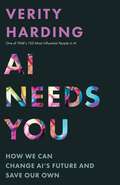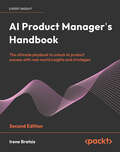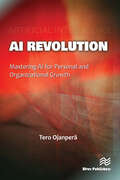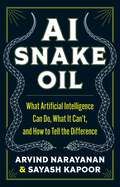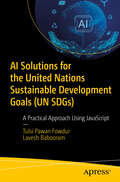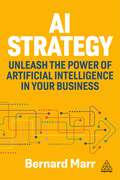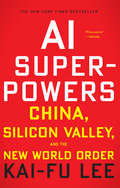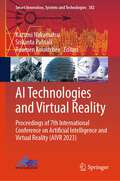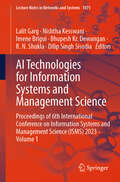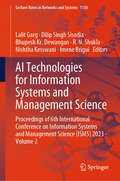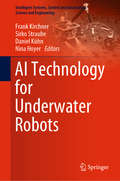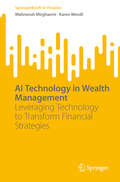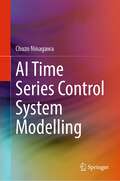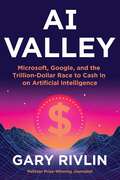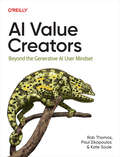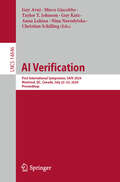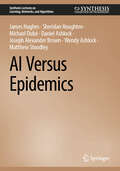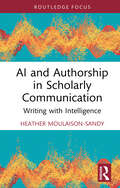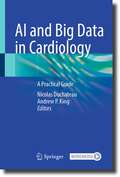- Table View
- List View
AI Literacy in K-16 Classrooms
by Samuel Kai Chu Davy Tsz Ng Jac Ka Leung Maggie Jiahong Su Iris Heung Yim Maggie Shen QiaoArtificial Intelligence is at the top of the agenda for education leaders, scientists, technologists and policy makers in educating the next generation across the globe. Beyond applying AI in daily life applications and educational tools, understanding how to learn and teach AI is increasingly important. Despite these emerging technology breakthroughs, AI learning is still new to educators especially to K-16 teachers. There is a lack of evidence-based studies that inform them about AI learning, including design principles for building a set of curriculum content, and pedagogical approaches as well as technological tools. Teaching AI concepts and techniques from programming languages and developmentally appropriate learning tools (e.g., robotics, serious games, software, intelligent agents) across different education levels emerged in recent years. The primary purpose of this book is to respond to the need to conceptualize the emerging term “AI literacy” and investigate how to teach and learn AI in K-16 education settings.This book examines different aspects of learning artefacts, pedagogies, content knowledge and assessment methods of AI literacy education, from theoretical discussions to practical recommendations for curriculum and instructional design. An exhaustive summary of current evidence with examples is illustrated in this book, as well as cutting-edge research that serves as an AI literacy model for different countries’ contexts. Part I, “Conceptualizing AI literacy”, provides a detailed discussion on the development of the concepts and frameworks on AI literacy education, discusses the differences and similarities between AI in education (AIED) and AI literacy education, and illustrates the reasons why K-16 students need to learn AI. These concepts are brought together in Part II, “K-16 AI literacy education” to further summarize the pedagogies, learning content, learning tools and assessment methods to inform K-16 educators how to design their AI instruction at each education level. After that, part III “AI literacy for instructional designers” explores how instructional designers (i.e., AI developers and teachers) prepare themselves to become ready to design developmentally appropriate tools, platforms, services and curricula to empower students with AI literacy skills.
AI Love You: Developments in Human-Robot Intimate Relationships
by Martin H. Fischer Yuefang ZhouUsing an interdisciplinary approach, this book explores the emerging topics and rapid technological developments of robotics and artificial intelligence through the lens of the evolving role of sex robots, and how they should best be designed to serve human needs. An international panel of authors provides the most up-to-date, evidence-based empirical research on the potential sexual applications of artificial intelligence. Early chapters discuss the objections to sexual activity with robots while also providing a counterargument to each objection. Subsequent chapters present the implications of robot sex as well as the security and data privacy issues associated with sexual interactions with artificial intelligence. The book concludes with a chapter highlighting the importance of a scientific, multidisciplinary approach to the study of human - robot sexuality. Topics featured in this book include: The Sexual Interaction Illusion Model. The personal companion system, Harmony, designed by Realbotix™. An exposition of the challenges of personal data control and protection when dealing with artificial intelligence. The current and future technological possibilities of projecting three-dimensional holograms. Expert discussion notes from an international workshop on the topic. AI Love You will be of interest to academic researchers in psychology, robotics, ethics, medical science, sociology, gender studies as well as clinicians, policy makers, and the business sector.
AI Management System Certification According to the ISO/IEC 42001 Standard: How to Audit, Certify, and Build Responsible AI Systems
by Sid Ahmed BenraouaneThe book guides the reader through the auditing and compliance process of the newly released ISO Artificial Intelligence standard. It provides tools and best practices on how to put together an AI management system that is certifiable and sheds light on ethical and legal challenges business leaders struggle with to make their AI system comply with existing laws and regulations, and the ethical framework of the organization.The book is unique because it provides implementation guidance on the new certification and conformity assessment process required by the new ISO Standard on Artificial Intelligence (ISO 42001:2023 Artificial Intelligence Management System) published by ISO in August 2023. This is the first book that addresses this issue.As a member of the US/ISO team who participated in the drafting of this standard during the last 3 years, the author has direct knowledge and insights that are critical to the implementation of the standard. He explains the context of how to interpret ISO clauses, gives examples and guidelines, and provides best practices that help compliance managers and senior leadership understand how to put together the AI compliance system to certify their AI system. The reader will find in the book a complete guide to the certification process of AI systems and the conformity assessment required by the standard. It also provides guidance on how to read the new EU AI Act and some of the U.S. legislations, such as NYC Local Law 144, enacted in July 2023.This is the first book that helps the reader create an internal auditing program that enhances the company’s AI compliance framework. Generative AI has taken the world by storm, and currently, there is no international standard that provides guidance on how to put together a management system that helps business leaders address issues of AI governance, AI structure, AI risk, AI audit, and AI impact analysis. ISO/IEC 42001:2023 is the first international mandatory and certifiable standard that provides a comprehensive and well-integrated framework for the issue of AI governance. This book provides a step-by-step process on how to implement the standard so the AI system can pass the ISO accreditation process.
AI Meets BI: Artificial Intelligence and Business Intelligence
by Lakshman Bulusu Rosendo AbelleraWith the emergence of Artificial Intelligence (AI) in the business world, a new era of Business Intelligence (BI) has been ushered in to create real-world business solutions using analytics. BI developers and practitioners now have tools and technologies to create systems and solutions to guide effective decision making. Decisions can be made on the basis of more reliable and accurate information and intelligence, which can lead to valuable, actionable insights for business. Previously, BI professionals were stymied by bad or incomplete data, poorly architected solutions, or even just outright incapable systems or resources. With the advent of AI, BI has new possibilities for effectiveness. This is a long-awaited phase for practitioners and developers and, moreover, for executives and leaders relying on knowledgeable and intelligent decision making for their organizations. Beginning with an outline of the traditional methods for implementing BI in the enterprise and how BI has evolved into using self-service analytics, data discovery, and most recently AI, AI Meets BI first lays out the three typical architectures of the first, second, and third generations of BI. It then takes an in-depth look at various types of analytics and highlights how each of these can be implemented using AI-enabled algorithms and deep learning models. The crux of the book is four industry use cases. They describe how an enterprise can access, assess, and perform analytics on data by way of discovering data, defining key metrics that enable the same, defining governance rules, and activating metadata for AI/ML recommendations. Explaining the implementation specifics of each of these four use cases by way of using various AI-enabled machine learning and deep learning algorithms, this book provides complete code for each of the implementations, along with the output of the code, supplemented by visuals that aid in BI-enabled decision making. Concluding with a brief discussion of the cognitive computing aspects of AI, the book looks at future trends, including augmented analytics, automated and autonomous BI, and security and governance of AI-powered BI.
AI Methods and Applications in 3D Technologies: Proceedings of 3DWCAI 2023 (Smart Innovation, Systems and Technologies #388)
by Srikanta Patnaik Roumen Kountchev Wenfeng Wang Roumiana KountchevaThis book features a collection of high-quality, peer-reviewed research papers presented at Second 'World Conference on Intelligent and 3D Technologies' (WCI3DT 2023), held in China during 26–28 May 2023. The book provides an opportunity to researchers and academia as well as practitioners from industry to publish their ideas and recent research development work on all aspects of 3D imaging technologies and artificial intelligence, their applications, and other related areas. The book presents ideas and the works of scientists, engineers, educators, and students from all over the world from institutions and industries.
AI Models for Blockchain-Based Intelligent Networks in IoT Systems: Concepts, Methodologies, Tools, and Applications (Engineering Cyber-Physical Systems and Critical Infrastructures #6)
by Bharat Bhushan Arun Kumar Sangaiah Tu N. NguyenThe goal of this book is to explore various security paradigms such as Machine Learning, Big data, Cyber Physical Systems, and Blockchain to address both intelligence and reconfigurability in various IoT devices. The book further aims to address and analyze the state of the art of blockchain-based intelligent networks in IoT systems and related technologies including healthcare sector. AI can ease, optimize, and automate the blockchain-based decision-making process for better governance and higher performance in IoT systems. Considering the incredible progress made by AI models, a blockchain system powered by intelligent AI algorithms can detect the existence of any kind of attack and automatically invoke the required defense mechanisms. In case of unavoidable damage, AI models can help to isolate the compromised component from the blockchain platform and safeguard the overall system from crashing. Furthermore, AI models can also contribute toward the robustness and scalability of blockchain-based intelligent IoT networks. The book is designed to be the first-choice reference at university libraries, academic institutions, research and development centers, information technology centers, and any institutions interested in integration of AI and IoT. The intended audience of this book include UG/PG students, Ph.D. scholars of this fields, industry technologists, young entrepreneurs, professionals, network designers, data scientists, technology specialists, practitioners, and people who are interested in exploring the role of AI and blockchain technology in IoT systems.
AI Needs You: How We Can Change AI's Future and Save Our Own
by Verity HardingA humanist manifesto for the age of AIArtificial intelligence may be the most transformative technology of our time. As AI&’s power grows, so does the need to figure out what—and who—this technology is really for. AI Needs You argues that it is critical for society to take the lead in answering this urgent question and ensuring that AI fulfills its promise.Verity Harding draws inspiring lessons from the histories of three twentieth-century tech revolutions—the space race, in vitro fertilization, and the internet—to empower each of us to join the conversation about AI and its possible futures. Sharing her perspective as a leading insider in technology and politics, she rejects the dominant narrative, which often likens AI&’s advent to that of the atomic bomb. History points the way to an achievable future in which democratically determined values guide AI to be peaceful in its intent; to embrace limitations; to serve purpose, not profit; and to be firmly rooted in societal trust.AI Needs You gives us hope that we, the people, can imbue AI with a deep intentionality that reflects our best values, ideals, and interests, and that serves the public good. AI will permeate our lives in unforeseeable ways, but it is clear that the shape of AI&’s future—and of our own—cannot be left only to those building it. It is up to us to guide this technology away from our worst fears and toward a future that we can trust and believe in.
AI Product Manager's Handbook: Build, integrate, scale, and optimize products to grow as an AI product manager
by Irene BratsisWhether you're a seasoned professional or a newcomer to the world of AI product management, this is your definitive guide. Embark on a transformative journey into the future of intelligent product management.Key FeaturesChart a successful career path in the AI product management field Packed with real-world examples, practical insights, and actionable strategiesNavigate the complexities of AI product development and evolve your existing products Book DescriptionThis book will provide you with a detailed roadmap for successfully building, maintaining, and evolving artificial intelligence (AI)-driven products, serving as an indispensable companion on your journey to becoming an effective AI PM. We'll explore the AI landscape, demystify complex terms, and walk you through infrastructure, algorithms, and deployment strategies. You’ll master essential skills to understand the optimal flow of AI processes, learn about the product development life cycle from ideation to deployment, and familiarize yourself with commonly used model development techniques. We'll discuss the intricacies of building products natively with AI, as well as evolving traditional software product to AI products. Regardless of your use case, we’ll show you how you can craft compelling stories to captivate your audience. We'll help you find the right balance between foundational product design elements and the unique aspects of managing AI products, so you can prioritize wisely. We’ll also explore career considerations for AI PMs. By the end of this book, you will understand the importance of AI integration and be able to explore emerging AI/ML models like Generative AI and LLMs. You’ll discover open-source capabilities and best practices for ideating, building, and deploying AI products across verticals.What you will learnPlan your AI PM roadmap and navigate your career with clarity and confidenceGain a foundational understanding of AI/ML capabilitiesAlign your product strategy, nurture your team, and navigate the ongoing challenges of cost, tech, compliance, and risk managementIdentify pitfalls and green flags for optimal commercializationSeparate hype from reality and identify quick wins for AI enablement and GenAIUnderstand how to develop and manage both native and evolving AI productsBenchmark product success from a holistic perspectiveWho this book is forThis book is for aspiring and experienced product managers, as well as other professionals interested in incorporating AI into their products. Foundational knowledge of AI is expected and reinforced. If you are looking to better understand machine learning principles and data science methodologies, you will benefit from this book, particularly if you’re in a role where the application of AI/ML directly influences marketing outcomes and business strategies.
AI Revolution: Mastering AI for Personal and Organizational Growth
by Tero Ojanperä""The AI Revolution"" is a practical guide to using new AI tools, such as ChatGPT, DALLE and Midjourney. Learn how to multiply your productivity by guiding or prompting AI in various ways. The book also introduces Microsoft Copilot, Google Bard, and Adobe Photoshop Generative Fill, among other new applications.ChatGPT reached a hundred million users in just two months after its release, faster than any other application before. This marked the advent of the generative AI era. Generative AI models generate text, images, music, videos, and even 3D models in ways previously thought impossible for machines. The book explains in an understandable manner how these AI models work.The book provides examples of how AI increases productivity, which professions are changing or disappearing, and how job markets will evolve in the coming years. With this book, you'll learn to recognize the opportunities and risks AI offers. Understand what this change demands from individuals and companies and what strategic skills are required. The book also covers legal questions caused by generative AI, like copyrights, data protection, and AI regulation. It also ponders societal impacts. AI produces content, thus influencing language, culture, and even worldviews. Therefore, it's crucial to understand by whom and how AI is trained. The AI revolution started by ChatGPT is just the beginning. This handbook is for you if you want to keep up with the rapid development of AI.
AI Snake Oil: What Artificial Intelligence Can Do, What It Can’t, and How to Tell the Difference
by Arvind Narayanan Sayash KapoorFrom two of TIME&’s 100 Most Influential People in AI, what you need to know about AI—and how to defend yourself against bogus AI claims and productsConfused about AI and worried about what it means for your future and the future of the world? You&’re not alone. AI is everywhere—and few things are surrounded by so much hype, misinformation, and misunderstanding. In AI Snake Oil, computer scientists Arvind Narayanan and Sayash Kapoor cut through the confusion to give you an essential understanding of how AI works and why it often doesn&’t, where it might be useful or harmful, and when you should suspect that companies are using AI hype to sell AI snake oil—products that don&’t work, and probably never will.While acknowledging the potential of some AI, such as ChatGPT, AI Snake Oil uncovers rampant misleading claims about the capabilities of AI and describes the serious harms AI is already causing in how it&’s being built, marketed, and used in areas such as education, medicine, hiring, banking, insurance, and criminal justice. The book explains the crucial differences between types of AI, why organizations are falling for AI snake oil, why AI can&’t fix social media, why AI isn&’t an existential risk, and why we should be far more worried about what people will do with AI than about anything AI will do on its own. The book also warns of the dangers of a world where AI continues to be controlled by largely unaccountable big tech companies.By revealing AI&’s limits and real risks, AI Snake Oil will help you make better decisions about whether and how to use AI at work and home.
AI Solutions for the United Nations Sustainable Development Goals (UN SDGs): A Practical Approach Using JavaScript
by Tulsi Pawan Fowdur Lavesh BabooramLearn the United Nations Sustainable Development Goals (UN SDGs) and see how machine learning can significantly contribute to their realization. This book imparts both theoretical knowledge and hands-on experience in comprehending and constructing machine learning-based applications for addressing multiple UN SDGs using JavaScript. The reading begins with a delineation of diverse UN SDG targets, providing an overview of previous successful applications of machine learning in solving realistic problems aligned with these targets. It thoroughly explains fundamental concepts of machine learning algorithms for prediction and classification, coupled with their implementation in JavaScript and HTML programming. Detailed case studies examine challenges related to renewable energy, agriculture, food production, health, environment, climate change, water quality, air quality, and telecommunications, corresponding to various UN SDGs. Each case study includes related works, datasets, machine learning algorithms, programming concepts, and comprehensive explanations of JavaScript and HTML codes used for web-based machine learning applications. The results obtained are meticulously analyzed and discussed, showcasing the pivotal role of machine learning in advancing the relevant SDGs. By the end of this book, you’ll have a firm understanding of SDG fundamentals and the practical application of machine learning to address diverse challenges associated with these goals. What You’ll Learn Understand the fundamental concepts of the UN SDGs, AI, and machine learning algorithms. Employ the correct machine learning algorithms to address challenges on the United Nations Sustainable Development Goals (UN SDGs)? Develop web-based machine learning applications for the UN SDGs using Javascript, and HTML. Analyze the impact of a machine learning-based solution on a specific UN SDG. Who This Book Is For Data scientists, machine learning engineers, software professionals, researchers, and graduate students.
AI Strategy: Unleash the Power of Artificial Intelligence in Your Business
by Bernard MarrIs your business truly ready for the AI revolution? Discover how to unlock the full potential of artificial intelligence and future-proof your organization with a winning AI strategy.AI is transforming every industry - is your business keeping up? In this essential guide, bestselling author and futurist Bernard Marr provides a comprehensive playbook for leaders looking to harness the power of AI. From understanding AI's transformative impact to developing a clear, actionable strategy, this book equips leaders with the tools they need to drive innovation, manage risks, and stay ahead in an AI-driven world.AI Strategy is the definitive guide for leaders ready to unlock AI's potential at scale. Covering every aspect of AI adoption - from ethical considerations and data management to employee upskilling and tech infrastructure - this book delivers real-world examples across multiple organizations and industries, from energy, healthcare and education to marketing and HR. Whether you're just starting or scaling fast, this must-read guide will help you confidently build and execute a winning AI strategy.
AI Superpowers: China, Silicon Valley, and the New World Order
by Kai-Fu LeeDr. Kai-Fu Lee—one of the world’s most respected experts on AI and China—reveals that China has suddenly caught up to the US at an astonishingly rapid and unexpected pace. <P><P>In AI Superpowers, Kai-fu Lee argues powerfully that because of these unprecedented developments in AI, dramatic changes will be happening much sooner than many of us expected. Indeed, as the US-Sino AI competition begins to heat up, Lee urges the US and China to both accept and to embrace the great responsibilities that come with significant technological power. <P><P>Most experts already say that AI will have a devastating impact on blue-collar jobs. But Lee predicts that Chinese and American AI will have a strong impact on white-collar jobs as well. Is universal basic income the solution? <P><P> In Lee’s opinion, probably not. But he provides a clear description of which jobs will be affected and how soon, which jobs can be enhanced with AI, and most importantly, how we can provide solutions to some of the most profound changes in human history that are coming soon. <P><b>A New York Times Bestseller</b>
AI Technologies and Virtual Reality: Proceedings of 7th International Conference on Artificial Intelligence and Virtual Reality (AIVR 2023) (Smart Innovation, Systems and Technologies #382)
by Srikanta Patnaik Kazumi Nakamatsu Roumen KountchevThis book gathers a collection of selected works and new research results of scholars and graduate students presented at the 7th International Conference on Artificial Intelligence and Virtual Reality (AIVR 2023) held in Kumamoto, Japan during July 21-23, 2023. The focus of the book is interdisciplinary in nature and includes research on all aspects of artificial intelligence and virtual reality, from fundamental development to the applied system. The book covers topics such as system techniques, performance, and implementation; content creation and modelling; cognitive aspects, perception, user behaviour; AI technologies; interactions, interactive and responsive environments; AI/VR applications and case studies.
AI Technologies for Information Systems and Management Science: Proceedings of 6th International Conference on Information Systems and Management Science (ISMS) 2023 - Volume 1 (Lecture Notes in Networks and Systems #1071)
by Lalit Garg Nishtha Kesswani Imene Brigui Dilip Singh Sisodia Bhupesh Kr. Dewangan R. N. ShuklaThis book explores the integration of artificial intelligence into various facets of information systems and management. It delves into machine learning, natural language processing, and computer vision applications, illustrating how these technologies revolutionize decision-making, optimization, and data analysis. Through case studies and theoretical frameworks, the book elucidates the transformative potential of AI in enhancing organizational efficiency and strategic planning, making it an essential reading for professionals and researchers navigating the intersection of AI and business. This book also highlights the efforts to build ethical norms and frameworks for AI adoption in MIS, as well as data privacy and security considerations.
AI Technologies for Information Systems and Management Science: Proceedings of 6th International Conference on Information Systems and Management Science (ISMS) 2023 - Volume 2 (Lecture Notes in Networks and Systems #1136)
by Lalit Garg Nishtha Kesswani Imene Brigui Dilip Singh Sisodia Bhupesh Kr. Dewangan R. N. ShuklaThis text will be replaced by the correct informationtext as soon as we get it.
AI Technology for Underwater Robots (Intelligent Systems, Control and Automation: Science and Engineering #96)
by Frank Kirchner Sirko Straube Daniel Kühn Nina HoyerThis book provides exclusive insight into the development of a new generation of robotic underwater technologies. Deploying and using even the most simple and robust mechanical tools is presenting a challenge, and is often associated with an enormous amount of preparation, continuous monitoring, and maintenance. Therefore, all disciplinary aspects (e.g. system design, communication, machine learning, mapping and coordination, adaptive mission planning) are examined in detail and together this gives an extensive overview on research areas influencing next generation underwater robots. These robotic underwater systems will operate autonomously with the help of the most modern artificial intelligence procedures and perform environmental monitoring as well as inspection and maintenance of underwater structures. The systems are designed as modular and reconfigurable systems for long term autonomy to remain at the site for longer periods of time. New communication methods using AI enable missions of hybrid teams of humans and heterogeneous robots. Thus this volume will be an important reference for scientists on every qualification level in the field of underwater technologies, industrial maritime applications, and maritime science.
AI Technology in Wealth Management: Leveraging Technology to Transform Financial Strategies (SpringerBriefs in Finance)
by Karen Wendt Mahnoosh MirghaemiThis book explores AI technology in wealth management, including what it is, how it changes the wealth management and private banking landscape, its advantages, and how it democratizes wealth management. Specifically, this book investigates topics such as Hyper-personalized investment strategies Combined quantitative analysis with sentiment analysis to create prescriptive and predictive scenarios Expandable and transparent AI algorithms in wealth management Customer experience and client engagement Tailored financial content Providing a clear and concise description of how AI driven wealth management differs from traditional investing, asset management, and wealth management offering new opportunities for investing, this book is ideal for students, scholars, researchers and professionals interested in accessible wealth management applications for investing in the 21st century.
AI Time Series Control System Modelling
by Chuzo NinagawaThis book describes the practical application of artificial intelligence (AI) methods using time series data in system control. This book consistently discusses the application of machine learning to the analysis and modelling of time series data of physical quantities to be controlled in the field of system control.Since dynamic systems are not stable steady states but changing transient states, the changing transient states depend on the state history before the change. In other words, it is essential to predict the change from the present to the future based on the time history of each variable in the target system, and to manipulate the system to achieve the desired change. In short, time series is the key to the application of AI machine learning to system control. This is the philosophy of this book: "time series data" + "AI machine learning" = "new practical control methods".This book can give my helps to undergradate or graduate students, institute researchers and senior engineers whose scientific background are engineering, mathematics, physics and other natural sciences.
AI Valley: Microsoft, Google, and the Trillion-Dollar Race to Cash In on Artificial Intelligence
by Gary RivlinA veteran Pulitzer Prize-winning journalist shadows the top thinkers in the field of Artificial Intelligence, introducing the breakthroughs and developments that will change the way we live and work. Artificial Intelligence has been “just around the corner” for decades, continually disappointing those who long believed in its potential. But now, with the emergence and growing use of ChatGPT, Gemini, and a rapidly multiplying number of other AI tools, many are wondering: Has AI’s moment finally arrived?In AI Valley, Pulitzer Prize-winning journalist Gary Rivlin brings us deep into the world of AI development in Silicon Valley. Over the course of more than a year, Rivlin closely follows founders and venture capitalists trying to capitalize on this AI moment. That includes LinkedIn founder Reid Hoffman, the legendary investor whom the Wall Street Journal once called, “the most connected person in Silicon Valley.”Through Hoffman, Rivlin is granted access to a number of companies on the cutting-edge of AI research, such as Inflection AI, the company Hoffman cofounded in 2022, and OpenAI, the San Francisco-based startup that sparked it all with its release at the end of that year of ChatGPT. In addition to Hoffman, Rivlin introduces us to other AI experts, including OpenAI cofounder Sam Altman and Mustafa Suleyman, the co-founder of DeepMind, an early AI startup that Google bought for $650 million in 2014. Rivlin also brings readers inside Microsoft, Meta, Google and other tech giants scrambling to keep pace.On this vast frontier, no one knows which of these companies will hit it big–or which will flame out spectacularly. In this riveting narrative marbled with familiar names such as Musk, Zuckerberg, and Gates, Rivlin chronicles breakthroughs as they happen, giving us a deep understanding of what’s around the corner in AI development. An adventure story full of drama and unforgettable personalities, AI Valley promises to be the definitive story for anyone seeking to understand the latest phase of world-changing discoveries and the minds behind them.
AI Value Creators
by Rob Thomas Paul Zikopoulos Kate SouleWe've arrived in a new era—GenAI is reshaping industries and decision-making processes across the board. As a result, understanding their potential and pitfalls has become crucial. But in order to stay ahead of the curve, you'll need to develop fresh perspectives on leveraging AI beyond mere technical know-how. Geared toward business leaders and tech professionals alike, this book demystifies the strategic integration of AI into business practices, ensuring you're equipped not just to participate but to lead in this new landscape. This insightful guide by industry leaders Rob Thomas, Paul Zikopoulos, and Kate Soule goes beyond the basics, offering real-life success stories and learned lessons to provide a blueprint for meaningful AI engagement. Whether you're a novice or a seasoned expert, you'll come away with an enhanced understanding of GenAI. Recognize the transformative potential of AI in business and how to harness itNavigate the ethical and operational challenges posed by AI with confidenceUnderstand the dynamic interplay between AI technology and business strategyImplement actionable strategies to integrate AI into your organizational cultureStep confidently into the role of an AI value creator, equipped to lead and innovate
AI Verification: First International Symposium, SAIV 2024, Montreal, QC, Canada, July 22–23, 2024, Proceedings (Lecture Notes in Computer Science #14846)
by Guy Katz Nina Narodytska Christian Schilling Guy Avni Mirco Giacobbe Taylor T. Johnson Anna LukinaThis LNCS volume constitutes the proceedings of the First International Symposium on AI Verification, SAIV 2024, in Montreal, QC, Canada, during July 2024. The scope of the topics was broadly categorized into two groups. The first group, formal methods for artificial intelligence, comprised: formal specifications for systems with AI components; formal methods for analyzing systems with AI components; formal synthesis methods of AI components; testing approaches for systems with AI components; statistical approaches for analyzing systems with AI components; and approaches for enhancing the explainability of systems with AI components. The second group, artificial intelligence for formal methods, comprised: AI methods for formal verification; AI methods for formal synthesis; AI methods for safe control; and AI methods for falsification.
AI Versus Epidemics (Synthesis Lectures on Learning, Networks, and Algorithms)
by James Hughes Daniel Ashlock Joseph Alexander Brown Sheridan Houghten Michael Dubé Wendy Ashlock Matthew StoodleyThis book presents algorithms and tools that are designed to model and extract information from personal contact networks, which represent which individuals in a population are physically in contact with one another. The authors developed these tools based on research they conducted during the COVID-19 pandemic, with the goal of improving responses to epidemics in the future. The book provides methods for modelling the transmission of infection across a population. The authors explain how an epidemic model can be used to strategically distribute vaccines and minimize the spread of a virus. The book shows how evolutionary computation, graph compression, and network induction can be utilized to manage issues that arise from an epidemic.
AI and Authorship in Scholarly Communication: Writing with Intelligence
by Heather Moulaison-SandyAI and Authorship in Scholarly Communication explores the role of artificial intelligence (AI) as it pertains to scholarly research and writing.Explaining what AI is and how it can be used by scholars, the book also focuses on aspects with the potential to change the scholarly communication landscape. Bringing together research on AI and writing from the scholarly literature in LIS and beyond, the book weaves together information about essential topics relating to AI and authorship. In laying out the primary concerns surrounding AI in the field of scholarly communication, Moulaison-Sandy considers how those concerns map to norms and practices in research and writing. The book likewise explores the future landscape of scholarly communication, an environment in which AI will continue to play an important role.AI and Authorship in Scholarly Communication will be of great interest to scholars, students, and practitioners and will be particularly useful to those studying AI or authorship from a library and information science (LIS) perspective. Researchers or practitioners working in higher education or with learning technologies will also find much to interest them within the pages of the book.
AI and Big Data in Cardiology: A Practical Guide
by Nicolas Duchateau Andrew P. KingThis book provides a detailed technical overview of the use and applications of artificial intelligence (AI), machine learning and big data in cardiology. Recent technological advancements in these fields mean that there is significant gain to be had in applying these methodologies into day-to-day clinical practice. Chapters feature detailed technical reviews and highlight key current challenges and limitations, along with the available techniques to address them for each topic covered. Sample data sets are also included to provide hands-on tutorials for readers using Python-based Jupyter notebooks, and are based upon real-world examples to ensure the reader can develop their confidence in applying these techniques to solve everyday clinical problems.Artificial Intelligence and Big Data in Cardiology systematically describes and technically reviews the latest applications of AI and big data within cardiology. It is ideal for use by the trainee and practicing cardiologist and informatician seeking an up-to-date resource on the topic with which to aid them in developing a thorough understanding of both basic concepts and recent advances in the field.
